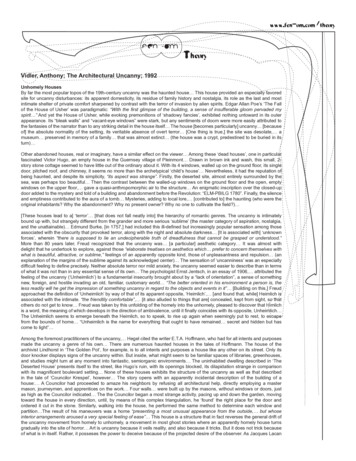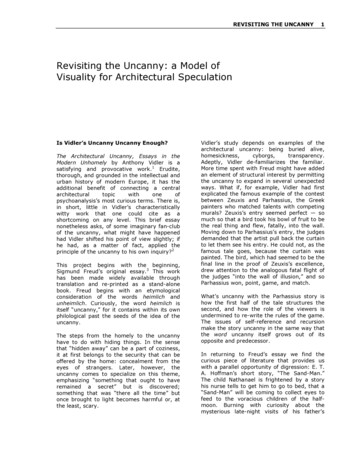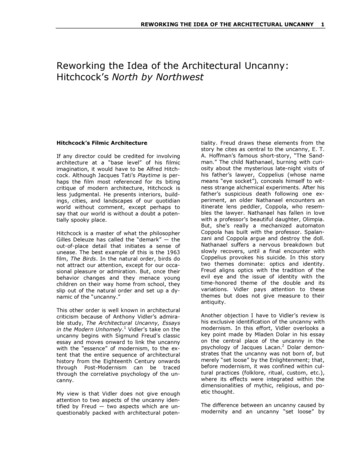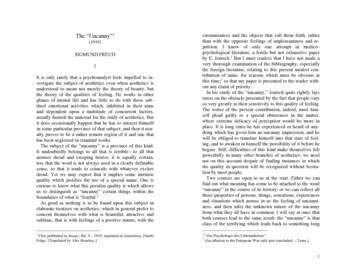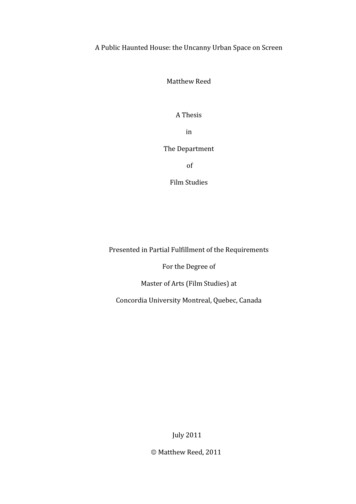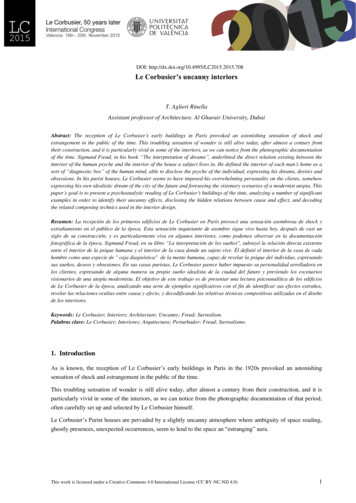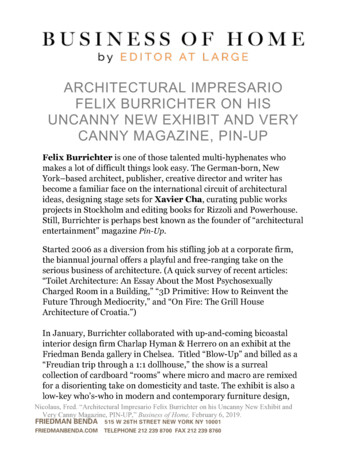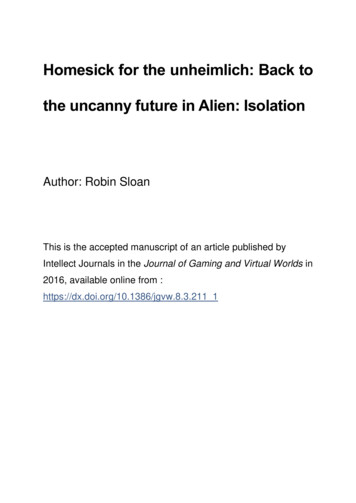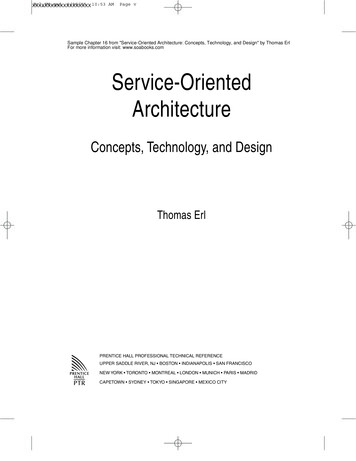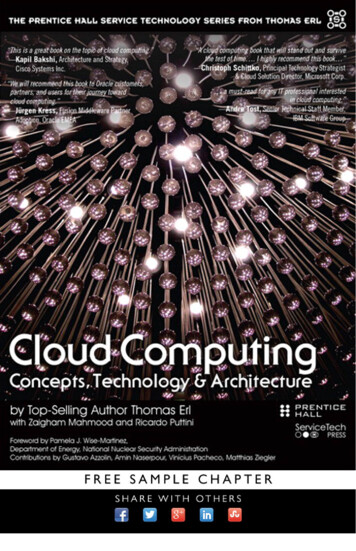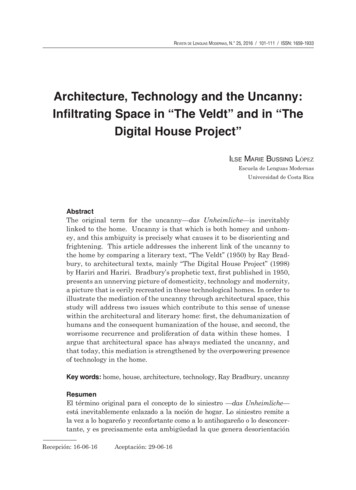
Transcription
Revista de Lenguas Modernas, N. 25, 2016 / 101-111 / ISSN: 1659-1933Architecture, Technology and the Uncanny:Infiltrating Space in “The Veldt” and in “TheDigital House Project”Ilse Marie Bussing LópezEscuela de Lenguas ModernasUniversidad de Costa RicaAbstractThe original term for the uncanny—das Unheimliche—is inevitablylinked to the home. Uncanny is that which is both homey and unhomey, and this ambiguity is precisely what causes it to be disorienting andfrightening. This article addresses the inherent link of the uncanny tothe home by comparing a literary text, “The Veldt” (1950) by Ray Bradbury, to architectural texts, mainly “The Digital House Project” (1998)by Hariri and Hariri. Bradbury’s prophetic text, first published in 1950,presents an unnerving picture of domesticity, technology and modernity,a picture that is eerily recreated in these technological homes. In order toillustrate the mediation of the uncanny through architectural space, thisstudy will address two issues which contribute to this sense of uneasewithin the architectural and literary home: first, the dehumanization ofhumans and the consequent humanization of the house, and second, theworrisome recurrence and proliferation of data within these homes. Iargue that architectural space has always mediated the uncanny, andthat today, this mediation is strengthened by the overpowering presenceof technology in the home.Key words: home, house, architecture, technology, Ray Bradbury, uncannyResumenEl término original para el concepto de lo siniestro —das Unheimliche—está inevitablemente enlazado a la noción de hogar. Lo siniestro remite ala vez a lo hogareño y reconfortante como a lo antihogareño o lo desconcertante, y es precisamente esta ambigüedad la que genera desorientaciónRecepción: 16-06-16Aceptación: 29-06-16
102Revista de Lenguas Modernas, N. 25, 2016 / 101-111 / ISSN: 1659-1933y terror. Este artículo se enfoca en la conexión intrínseca entre lo siniestro y el hogar,al comparar un texto literario, “The Veldt” (1950) de Ray Bradbury, con textos arquitectónicos, principalmente “The Digital House Project” (1998) por Hariri y Hariri. El textoprofético de Bradbury, publicado en 1950, presenta una imagen desconcertante de ladomesticidad, de la tecnología y de la modernidad, una imagen que es recreada en estascasas tecnológicas. Con el fin de ilustrar la mediación de lo siniestro a través del espacioarquitectónico, este análisis se enfocará en dos aspectos que contribuyen a esta sensaciónde turbación dentro del hogar en el plano arquitectónico y literario: primero, la deshumanización de los individuos y la consecuente humanización de la casa, y segundo, larecurrencia preocupante y la proliferación de información dentro de estas casas. Insistoen que el espacio arquitectónico siempre ha mediado lo siniestro y que, actualmente, estamediación se fortalece por la presencia abrumadora de la tecnología en el hogar.Palabras claves: hogar, casa, arquitectura, tecnología, Ray Bradbury, lo siniestroThe original term for the uncanny—dasUnheimliche—isinevitably linked to the home.Uncanny is that which is both homeyand unhomey, and this ambiguity is precisely what causes it to be disorientingand frightening. This article addressesthe inherent link of the uncanny tothe home by comparing a literary text,“The Veldt” (1953) by Ray Bradbury, toarchitectural texts, mainly “The DigitalHouse Project” (1998) by Hariri andHariri. Bradbury’s prophetic text, firstpublished in 1950, presents an unnerving picture of domesticity, technologyand modernity, a picture that is eerilyrecreated in these technological homes.In order to illustrate the mediation of theuncanny through architectural space,this study will address two issues whichcontribute to this sense of unease withinthe architectural and literary home: first,the dehumanization of humans and theconsequent humanization of the house,and second, the worrisome recurrenceand proliferation of data within thesehomes. I argue that architectural spacehas always mediated the uncanny, andthat today, this mediation is strengthened by the overpowering presence oftechnology in the home.The 1950s as Historical BackdropThe 1950s, the decade in whichBradury’s text emerged, undoubtedlyshaped this tale; New Historicism andnumerous criticics have proven thathistorical contexts are one of variousdiscourses that need to be consideredwhile analyzing a text, and in this case,this approach becomes imperative because of particular socio-cultural aspects of American culture at the time,which surface very clearly in the story.“The Veldt” (1953) discusses the eventsin the “Happylife Home,” a house of thefuture, which today would be called an“intelligent” or “smart” home. At firstglance, the world of the 1950s seemsto clash enormously with the futuristicand ominous reality that is showcasedin “The Veldt.” Nevertheless, during this
BUSSING. Arquitecture, Technology and the Uncanny .historical period, the United States experienced socio-economic changes thatinaugurated a new era in Americanhistory, characterized in large part bytechnological innovation and consumeristic excess: “The economy as a wholeunderwent sweeping transformations.Under the growing dominance of largeindustrial conglomerates, the postwar era was very prosperous, withaverage annual earnings for all workers more than doubling while inflation remained low. This pushed mostAmericans towards a pattern of intensive consumption” (Carosso 9). Thesame author notes the intimate linkbetween this insatiable consumerismand the unprecendented amount ofnew appliances that were now available: “This was America under thereassuring spell of the television sitcom, enjoying the purported glamourof the suburban home and its endlessarray of never-before-seen appliances,where consumption was understoodas a close synonym of happiness” (8).“The Veldt” clearly reflects the deeptransformations that American culture was undoubtedly suffering in thisdecade because of innovation, but alsobecause of its dark twin, consumerism.Heightened consumerism was notthe only significant social change experienced by Americans during the 1950s.The family unit also underwent, if nota drastic transformation, certainly anintense reaffirmation of fixed genderroles of its leading members: “It was theAmerica in which dad was the breadwinner and mom the homemaker, and homeand car-ownership appeared to be natural facts of life” (Carosso 8). Moreover,this idealized two-parent family had aparticular flavor because of the suburban lifestyle that reigned at the time:103“The expansion of industrial productionof small consumer durables required, inthe USA as in the UK, an investment inthe home, and the drive towards homogeneity resulted in these homes being increasingly located in new suburban developments accesed by new automobiles,fuelled in America by home-producedand cheap gasoline” (Thumim 7).According to Janet Thumim, the Fifties were defined by this suburban existence, by the emergence of the televisionindustry, and by the convergence of thesetwo phenomena—watching television asan essential part of family life and routine. Thumim also affirms that the notion of the Fifties that emerges is shapedby images of “not so much the Fifties asthey were, rather the Fifties as contemporary programmes proposed them tobe” (5). But, as with any era, these images formed fundamental myths thatpainted a positive picture of the 1950s,as well as other myths that revealed thedarker underbelly of the times:From such material unifying mythsemerge, myths suggesting a goldenage explosion of consumer goods andemployment opportunities, of the establishment of harmonious two-parentfamilies in leafy suburbs, of the promise and excitement of new technologies And then there are the oppositemyths of repressed, anxious citizensstruggling to live decent lives in postwar wastelands, of the restricting double standard reapplied to women following their wartime emancipation ofthe rise in crime amongst juveniles, ofthe misery of unwelcome immigrants,of racism, poverty, mental ill-health.Neither of these extremes does justiceto the provisional, contradictory andexperimental realities. (Thumim 5,6)
104Revista de Lenguas Modernas, N. 25, 2016 / 101-111 / ISSN: 1659-1933Carosso confirms this dual depiction of the era in the “real” world, whilepointing out some of the bleaker elements that marked this decade: “The1950s was the era of the Cold War andthe constant threat of nuclear annihilation, when nuclear fallout shelterswere constructed in public buildingsand schools; it was the America of McCarthy’s crusade against ‘unAmericanactivities’ and of the Hollywood blacklists, a country in which racial segregation was largely legal” (8). In otherwords, critics coincide in the idea that,as with any era, idealized portrayalsare only one side of the coin; the 1950swas a decade in which happy-familyportrayals, so prevalent on the TV ofthe time, acted like a glossy picturethat covered up darker social and cultural realities that lurked beneath.“The Veldt” and “Real” IntelligentHomesRay Bradbury’s story tunes in tothis dual portrayal of this decade; thebeginning of the story paints a seemingly happy family existence but thissetting soon turns nightmarish whenthe children rebel against parentalauthority and when the house itselfno longer serves the family, but acquires a dangerous autonomy andpower over the parents and even thechildren. Initially, the parents and thetwo children don’t have to perform anychores such as cooking or brushingtheir teeth, since the house does it forthem. Furthermore, the children become obsessive about playing in theirvirtual-reality nursery, which they insist on turning into an African veldt.Sinister elements emerge as the storyprogresses, such as a sense that thereality of the nursery is “all-too-real.”Moreover, the traditional family structure is undermined, since the childrenconsistently challenge and threatenparental authority. Near the end of thetale, the parents decide to shut off theentire house in order to regain authority. Nevertheless, this decision seems tocome late, since the children lock theirparents in the nursery and the latterdisappear when the not-so-virtual lionsapparently eat them.The issue of the animate room andhouse transmits Bradbury’s anxieties about the overwhelming influenceof television on everyday family life.Media critics often point out a famousquote by the author, in which his viewsabout the pernicious effects of television are revealed: “The television, thatinsiduous beast, that Medusa whichfreezes a billion people to stone everynight, staring fixedly. That siren whichcalled and sang, and promised so muchand gave, after all, so little” (Wasko 8).In the story, the wall in the children’snursery, which depicts virtual realities, clearly portrays the author’s apprehension concerning the invasion ofthe television set into American homesat the time of the publication of the story (the tale first appeared in The Saturday Evening Post, on September 23,1950). “The Veldt,” then, reveals anxieties facing 1950s American culture,specifically fears connected to familylife and its voracious appetite for thenewer technologies that, as Bradburypointed out, seemed to promise so muchbut gave so little, or rather, gave newsocial and family problems in return.In this article I also argue that Bradbury’s prophetic literary text announceda reality that was not far to come, that
BUSSING. Arquitecture, Technology and the Uncanny .of “smart homes” which boast advancedtechnology that is marketed as improvingfamily life. “The Digital House Project,”the architectural project that Bradbury’sstory will be compared to, was developedby Iranian architects, Gisue and MojganHariri for House Beautiful magazine in1998, in order to illustrate the central roleof new technologies in modern and future homes. The architects strived to create an entirely digitalized environment,with walls made from liquid-crystalsand factory-made rooms, “plugged” intoa main core. The fact that this is a project and not a built structure, adds to thesense of the uncanny, since it exists on adigital plane, competing with and questioning the reality of our own immediateexistence. Bradbury’s story presents ascenario that was interpreted as sciencefiction in its day, but in our context, theinternet, artificial intelligence, and virtual reality are no longer fantasy. The result, of course, is a blurring of the frontierbetween the Virtual and the Real. Thenewest advances in artificial intelligenceare what really shape this new house:“As a receiver and transmitter of information, the house also becomes an extension of the mind” (Riley 56). At this point,it is necessary to consider the definitionfor an intelligent home. While Programmable and Intelligent homes are alike,the word intelligent (vs. programmable)automatically implies that the house hasthinking capacity, a mind and an “intelligence” of sorts:In case of Programmable House Technologies, it was a human that needed toprogram or reprogram the house. In caseof Intelligent Houses, it would be doneautomatically by the house itself. This isachieved by the capability of the houseto observe the inhabitants in the search105for patterns. www2.imm.dtu.dk/ cdj/rtHouseWebSite/scenarios.html At a first glance, it might appearthat the advent of this type of “thinking” home is an isolated and revolutionary occurrence. However, as Phillip Sauter argues in “Vr2Gotm a NewMethod for Virtual Reality Development,” the concept of virtual realitymay be traced as far back as classical sources. According to this author,this concept can be traced to a writtensource dating from 370 B.C., specifically to Plato’s Book VII of the Republic, in which the philosopher discussesthe “Allegory of the Cave,” centeringon “ideas of perception, reality and illusion” (Sauter 1). In addition to pointing to this ancient preoccupation withreality and virtuality, Saute
uncanny through architectural space, this study will address two issues which contribute to this sense of unease within the architectural and literary home: first, the dehumanization of humans and the consequent humanization of the house, and second, the worrisome recurrence and proliferation of data within these homes. I argue that architectural space has always mediated the uncanny, and that .
